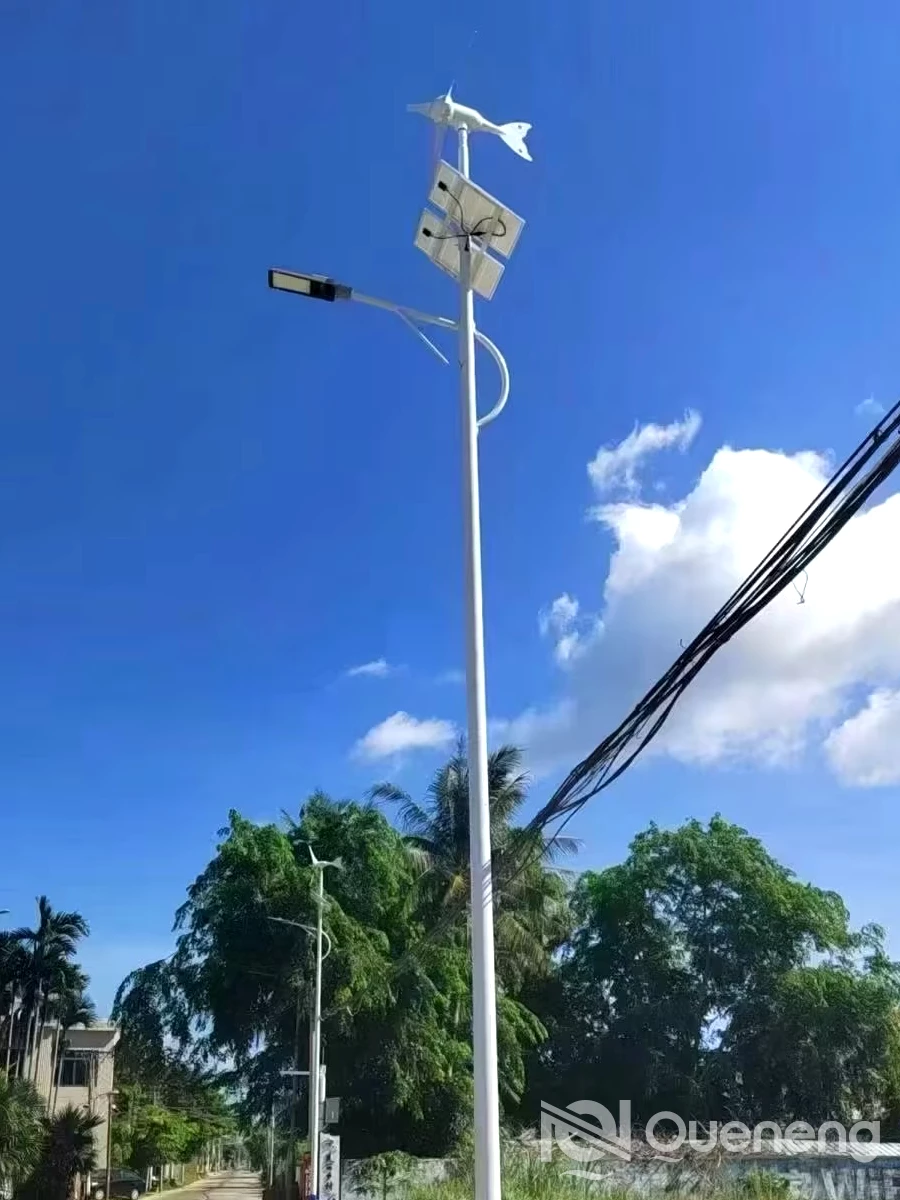As global demand for clean and renewable energy grows, wind-solar complementary street lights—also known as hybrid solar-wind street lights—are emerging as an effective, reliable, and sustainable outdoor lighting solution. These smart lighting systems combine solar and wind power to operate independently of the electrical grid and maintain stable performance in various weather conditions.
1. What Is a Wind-Solar Complementary Street Light?
A wind-solar complementary street light is a self-powered lighting system that integrates solar photovoltaic panels and a small wind turbine into one unit. Both sources generate electricity, which is stored in batteries and used to power high-efficiency LED lights. The system ensures continuous operation even during nighttime or cloudy weather when sunlight is insufficient.
2. How Does It Work?
- Solar Panels: Capture sunlight during the day and convert it into electricity.
- Wind Turbine: Produces electricity using wind energy, especially effective at night or during overcast days.
- MPPT Controller: Manages both inputs, protects the battery, and ensures maximum power point tracking.
- Battery: Stores the generated energy and powers the LED lighting system.
- Optional Smart Controller: Enables remote monitoring, real-time fault detection, and intelligent dimming via IoT.
3. Key Advantages
- 24/7 Power Supply
- Off-Grid Capability
- Environmentally Friendly
- Smart Energy Management
- Reliable in Harsh Weather
- Cost-Effective Long-Term
4. Common Applications
- Coastal highways and port roads
- Remote mountain roads and villages
- Deserts and windy plains
- Border outposts or military checkpoints
- Off-grid eco-resorts and organic farms
- Emergency or disaster relief zones
5. Comparison: Wind-Solar vs. Traditional Solar Street Lights
| Feature | Solar Street Light | Wind-Solar Hybrid Street Light |
|---|---|---|
| Energy Source | Solar only | Solar + Wind |
| Performance in Weather | Weak on cloudy days | Stable with dual energy input |
| Initial Cost | Lower | Slightly higher |
| Ideal for | Sunny locations | Windy or mixed-weather regions |
| Power Stability | Relies solely on sunlight | Enhanced reliability |
6. How to Choose a Wind-Solar Hybrid System?
- For coastal or high-salinity areas, select anti-corrosion materials.
- Use MPPT controllers that support dual solar and wind input.
- Match wind turbine power (commonly 200–600W) to local wind speeds.
- Choose LiFePO₄ batteries for longer lifespan and safety.
- Opt for IoT-enabled controllers for smart city integration.
7. Cost & ROI
While wind-solar complementary lights require a higher upfront cost than conventional solar lights, they deliver better performance in cloudy or off-grid areas. Over time, they reduce maintenance and electricity costs, making them an economically sound long-term investment.
8. Conclusion
Wind-solar complementary street lights represent a smart, eco-friendly solution for modern outdoor lighting. By utilizing both solar and wind energy, they ensure stability, sustainability, and off-grid autonomy. These hybrid systems are ideal for regions with inconsistent sunlight or high wind and play a key role in the future of smart cities and green infrastructure.
GuangDong Queneng Lighting Technology Co., Ltd. specializes in high-performance solar and wind-solar street lighting systems. Backed by ISO 9001, CE, UL, TÜV and more, we offer customized lighting solutions tailored to your project needs.
Contact us for a free consultation or technical support.
FAQ – Frequently Asked Questions
- Q1: Can wind-solar street lights operate during storms or at night?
- Yes. The wind turbine generates power when solar energy is unavailable—such as at night or during cloudy, rainy, or stormy conditions.
- Q2: What wind speed is needed to generate power?
- Most turbines start producing electricity at 2.5–3 meters per second. Optimal efficiency is achieved at 10–12 m/s.
- Q3: Is maintenance more complicated than solar-only systems?
- Not significantly. Wind turbines require occasional inspection and lubrication, but modern designs are made for low maintenance.
- Q4: Can I upgrade an existing solar light to include a wind turbine?
- Only if the controller and battery system support dual inputs. For optimal performance, it’s best to install an integrated hybrid system.
- Q5: Are wind turbines noisy or dangerous?
- No. High-quality wind turbines operate quietly (under 40 dB) and include built-in safety features like automatic braking in high winds.
-


























